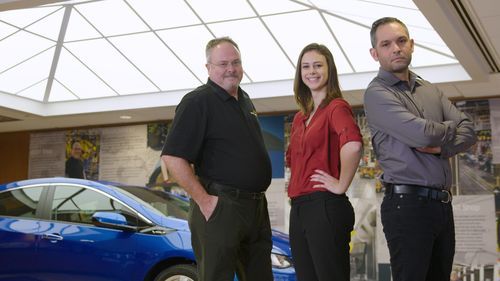
GM employees Al Hildreth, global energy manager, left; Erin Lawrence, associate energy engineer; and Brian Wilger, senior environmental engineer, explored the L’Oreal factory.
(Photo: GM)
What do a car factory and a cosmetics factory have in common? More than you might expect.
General Motors Co. and L’Oreal USA temporarily swapped energy management teams earlier this month as part the Better Buildings Challenge SWAP, a public-private partnership through the Department of Energy designed to help businesses explore new ways to reduce energy use and improve productivity. The excursions are tapped and packaged as webisodes on the DOE’s Better Buildings YouTube page, providing the public with a behind-the-scenes look at efforts to improve manufacturing through energy efficiency.
“You might expect the factories to be really different, but it’s just a different scale and a different speed. Other than that, there’s still a lot of robots doing a lot of the work, but with people operating their lines,” said Erin Lawrence, an associate energy engineer for GM who trekked down to Little Rock to visit the L’Oreal factory. “It looked really familiar to me once we got inside their plant.”
Lawrence and her colleague Brian Wilger, an environmental engineer for GM’s Detroit-Hamtramck plant, explored the L’Oreal factory with their boss, Al Hildreth, GM’s global energy manager, while a team from L’Oreal came up to Detroit-Hamtramck.
The GM team took a break from moving metal to navigate assembly lines for lip gloss, nail polish and mascara looking for opportunities for the cosmetics manufacturer to improve efficiency through better monitoring of air leaks and optimizing heating. And on this energy-efficiency treasure hunt, the GM team also brought home a few new tricks.
As a result, Lawrence and Wilger are evaluating a few tweaks at Detroit-Hamtramck — GM’s 4 million-square-foot facility that produces the Chevrolet Volt and Impala, the Cadillac CT6 and the Buick Lacrosse — including switching to more energy-efficient LED lights in some areas and turning off compressed air to machines when they aren’t in use.
In recent years, Detroit-Hamtramck team leader Dwayne Alexander has already worked with his team to set monthly environmental goals, that range from finding better ways to recycle to saving energy at each work space. Camille Ryans, a line worker at Detroit-Hamtramck who installs windshields, said this teamwork approach to energy savings at the plant has made things like shutting off lights or monitors when they aren’t in use “a routine.”
“So when L’Oreal came, it wasn’t like ‘Oh, someone else is coming in today, let me sweep,’” Ryans said. “It was more-so like, ‘This is what we do every day.’”
Still, Ryans said she’s already implemented an energy-savings suggestion from L’Oreal at her workspace, leaving one of the lights at her station turned off unless it’s needed.
“It was just one of those things like, when I turned on my robot in the morning, I turned this light on,” she said. “But the robot doesn’t need any light, so we don’t turn that particular light on anymore unless something is going on with maintenance or something like that.”
NNaughton@detroitnews.com
Read or Share this story: https://detne.ws/2qOQd4b
